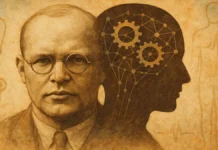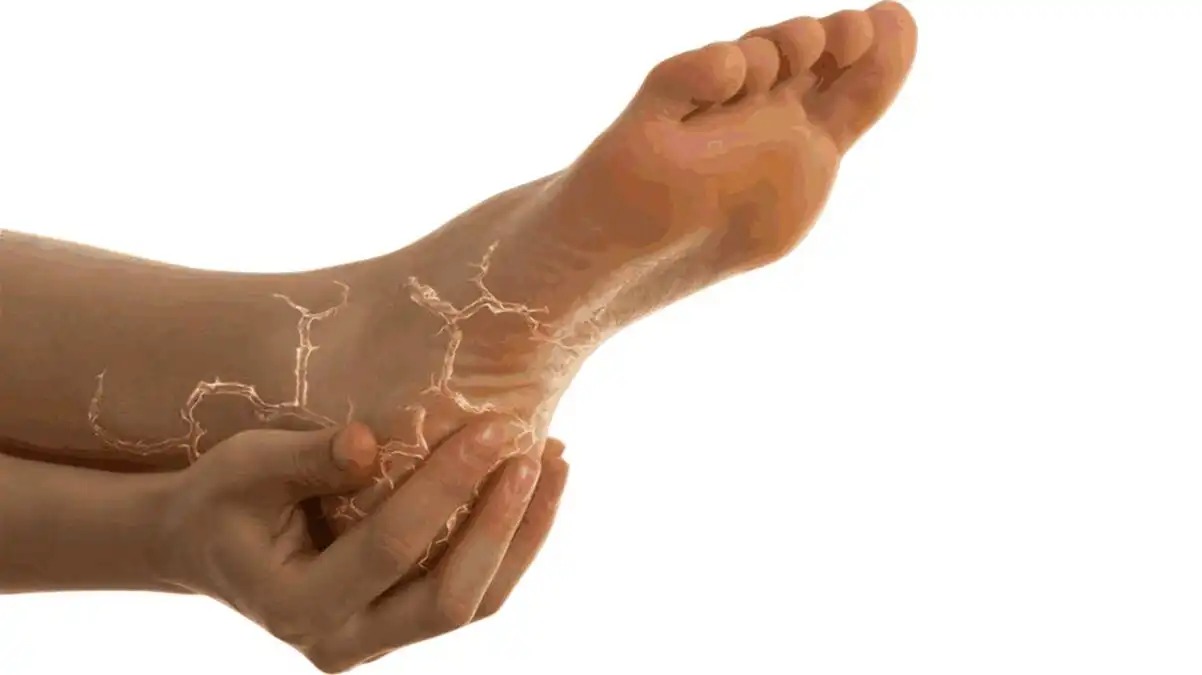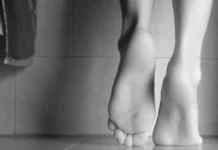The above image depict an Early 20th and Late 19th Century Homeopathy Hospitals in the USA
The late 19th and early 20th centuries were a transformative period for homeopathy in the United States. Homeopathy, a system of alternative medicine founded by Samuel Hahnemann in the late 18th century, found a receptive audience in America.
Rise of Homeopathy in the USA: Homeopathy arrived in the United States in the 1820s, gaining momentum over the following decades. By the mid-19th century, it had become a well-respected and popular medical practice. This rise was partly due to the dissatisfaction with conventional medicine of the time, which often involved harsh treatments like bloodletting and purging. Homeopathy’s gentler approach, which emphasized the body’s natural ability to heal, appealed to many patients and practitioners.
Prominent Homeopathic Hospitals: Several prominent homeopathic hospitals were established during this period, each playing a crucial role in advancing the practice and acceptance of homeopathy in the United States:
- New York Homeopathic Medical College and Flower Hospital: Founded in 1860, this institution became one of the most influential homeopathic hospitals in the country. It was known for its rigorous medical training and its commitment to integrating homeopathic principles with conventional medical education.
- Hahnemann Hospital of Philadelphia: Named after the founder of homeopathy, this hospital was established in 1848. It became a leading center for homeopathic treatment and education, offering a wide range of medical services based on homeopathic principles.
- Boston University School of Medicine: In the late 19th century, Boston University integrated homeopathy into its medical curriculum, establishing a homeopathic medical school and hospital. This integration reflected the broader acceptance of homeopathy in American medical education.
- Cook County Hospital in Chicago: In the early 20th century, this hospital had a homeopathic division, reflecting the integration of homeopathic practices in public healthcare institutions.
Introduction
The Surge of Alternative Medicine in the 19th Century
The 19th century was a period of profound transformation and innovation, marked by significant advancements in science, industry, and societal structures. This era, often referred to as the Age of Enlightenment, heralded a shift in the way people viewed the world, including their approach to health and medicine. Traditional medical practices, rooted in ancient theories and often harsh treatments, began to be questioned. In response to the limitations and sometimes brutal nature of conventional medicine, various alternative medical practices emerged, offering gentler, more holistic approaches to health and healing.
During this time, several key figures and movements laid the foundation for what we now recognize as alternative medicine. Homeopathy, developed by Samuel Hahnemann, emphasized the principle of “like cures like” and utilized highly diluted substances to treat illnesses. Hydrotherapy, popularized by Vincent Priessnitz and Sebastian Kneipp, leveraged the healing properties of water in various forms. Mesmerism, or animal magnetism, introduced by Franz Anton Mesmer, explored the therapeutic potential of a universal magnetic fluid, which later influenced the development of hypnotherapy. These practices, among others, reflected a growing dissatisfaction with the conventional medical paradigm and a yearning for more natural, patient-centered care.
Who was Franz Anton Mesmer?
Franz Anton Mesmer (1734-1815) was a German physician known for his theories on animal magnetism and his controversial therapeutic practices. He is considered one of the founders of modern hypnosis.
Animal Magnetism
Mesmer believed that all living beings were endowed with a universal magnetic fluid, which he called “animal magnetism.” He thought that this fluid could be manipulated through magnetic passes and other techniques to cure a variety of ailments, including nervous disorders, chronic pain, and psychological problems.
Mesmerism
Mesmer’s therapeutic practices, which often involved group sessions with music and dim lighting, were known as “mesmerism.” His patients often entered states of trance or ecstasy, and some attributed their healing to Mesmer’s powers.
Controversy and Legacy
Mesmer’s theories and practices were the subject of much criticism and controversy during his lifetime. Some accused him of being a charlatan and exploiting his patients. Others claimed that his techniques had no scientific basis.
Despite the controversies, Mesmer had a significant influence on the development of modern hypnosis. His work inspired later researchers such as James Braid and Jean-Martin Charcot, who helped establish hypnosis as a legitimate therapeutic technique.
Interesting Facts about Mesmer
Mesmer was an accomplished musician and often played the harpsichord during his mesmerism sessions.
He was also a friend of the composer Wolfgang Amadeus Mozart.
Mesmer’s theories influenced writers and artists such as Honoré de Balzac and Edgar Allan Poe.
The term “mesmerism” is still sometimes used today to refer to hypnosis or other techniques of suggestion.
In conclusion, Franz Anton Mesmer was a controversial but important figure in the history of medicine and psychology. His theories on animal magnetism and his therapeutic practices laid the groundwork for modern hypnosis.
The cultural and intellectual climate of the 19th century played a significant role in the proliferation of these alternative practices. The Industrial Revolution brought about unprecedented social and economic changes, leading to urbanization and new health challenges. This period also saw a rise in individualism and self-reliance, encouraging people to take control of their health and seek out alternative therapies. Increased literacy rates and the spread of printed materials facilitated the dissemination of new medical ideas, while a growing interest in spiritualism and mysticism further fueled the popularity of holistic health approaches.
Purpose and Scope of the Article
This article aims to explore the rise of alternative medicine in the 19th century, focusing on the socio-cultural and intellectual factors that contributed to its development. By examining the broader context in which these practices emerged, we can gain a deeper understanding of their enduring appeal and influence on modern healthcare.
The article will begin by delving into the Enlightenment and its impact on medicine, highlighting key scientific advancements and the resultant shifts in medical philosophy. It will then explore the cultural and intellectual shifts of the era, emphasizing the role of individualism, literacy, and holistic health movements in shaping alternative medicine.
A significant portion of the article will be dedicated to discussing prominent figures and practices in alternative medicine, such as homeopathy, hydrotherapy, and mesmerism. Following this, the focus will shift to the birth of osteopathy, tracing the life and philosophy of its founder, Andrew Taylor Still. Beyond the personal tragedy that motivated Still, the article will explore the broader intellectual and cultural influences that shaped his medical approach.
In conclusion, the article will reflect on the historical context of alternative medicine in the 19th century and its lasting impact on contemporary healthcare practices. By providing a comprehensive overview of this transformative period, the article aims to illuminate the origins and evolution of alternative medicine, with a particular focus on osteopathy.
The Enlightenment and Its Impact on Medicine
Scientific Advancements and Their Influence
The Enlightenment, spanning the 17th and 18th centuries, laid the intellectual groundwork for the 19th century’s medical revolution. Characterized by a spirit of inquiry, skepticism of tradition, and an emphasis on reason and empirical evidence, the Enlightenment spurred numerous scientific advancements that transformed medicine.
One of the most notable influences was the development of the scientific method, which emphasized systematic observation, measurement, experimentation, and the formulation of hypotheses. Figures like Isaac Newton and René Descartes promoted a rational approach to understanding the natural world, which began to be applied to medicine. This led to significant progress in fields such as anatomy, physiology, and pathology.
For instance, the work of Andreas Vesalius in the 16th century on human anatomy provided a more accurate understanding of the human body, challenging Galenic doctrines that had dominated for centuries. By the 19th century, this foundation was built upon by figures like Claude Bernard, whose work on the physiological processes of the body helped establish the principles of homeostasis.
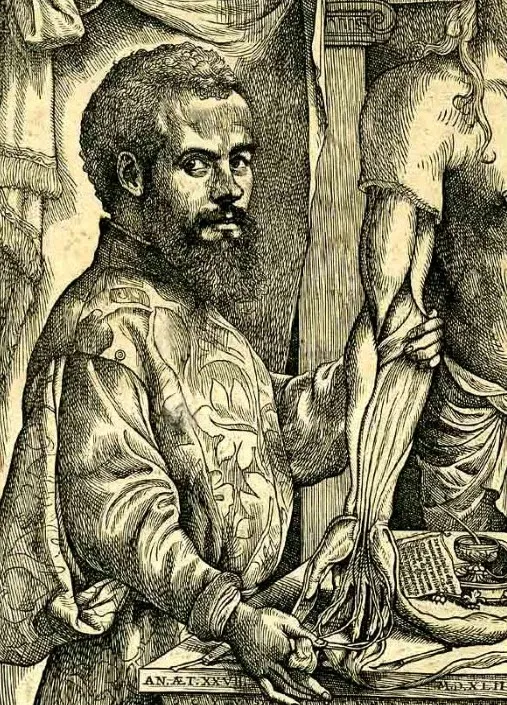
This illustration by Andreas Vesalius, a pioneering figure in anatomy during the Renaissance, highlights the detailed study of the human arm. Published in 1543 in his groundbreaking work De humani corporis fabrica, Vesalius’s meticulous anatomical drawings laid crucial groundwork for understanding the musculoskeletal system. His work, emphasizing the importance of anatomical accuracy, influenced future medical practitioners, including Andrew Taylor Still, who sought to improve and refine the practice of medicine by integrating anatomical insights with holistic approaches. Vesalius’s contributions underscore the enduring impact of anatomical studies on the development of alternative and conventional medical practices alike.
The discovery of microorganisms by Antonie van Leeuwenhoek and the subsequent development of germ theory by Louis Pasteur and Robert Koch revolutionized the understanding of disease causation, shifting the focus from miasma theories to the identification and treatment of specific pathogens. These scientific advancements not only enhanced the accuracy of diagnoses but also paved the way for the development of new treatments and preventive measures, such as vaccines.
The Industrial Revolution: Social and Economic Transformations
The Industrial Revolution, beginning in the late 18th century, brought about profound social and economic transformations that influenced medicine. The rapid urbanization and industrialization led to significant changes in living conditions, work environments, and societal structures, which in turn affected public health.

Left: Pre-Industrial Era
Before the Industrial Revolution, life was characterized by agrarian economies, manual labor, and small-scale craftsmanship. Communities were often rural, with limited technological advancements. Traditional practices and slow, labor-intensive methods defined daily life and work.
Right: Post-Industrial Revolution
The Industrial Revolution, beginning in the late 18th century, brought profound changes. Mechanization, urbanization, and technological advancements transformed production processes, leading to mass production and significant economic growth. Cities expanded rapidly, and industrial advancements reshaped societal structures and lifestyles, marking a dramatic shift from pre-industrial traditions.
This visual comparison highlights the dramatic shifts in industry, economy, and daily life brought about by the Industrial Revolution, setting the stage for the rise of new medical practices and alternative medicine in the 19th century.
Cities swelled with populations seeking work in factories, leading to overcrowded living conditions and inadequate sanitation. These conditions were fertile grounds for the spread of infectious diseases such as cholera, tuberculosis, and typhoid fever. The increased prevalence of such diseases highlighted the limitations of existing medical practices and underscored the need for improved public health measures and medical treatments.
The economic changes also led to a growing middle class that had greater access to education and medical knowledge. This class began to demand better healthcare services and became more skeptical of traditional medical practices. The rise of the printing press and increased literacy rates meant that medical knowledge could be disseminated more widely and rapidly, contributing to public debates about the efficacy of various medical practices.
Additionally, the Industrial Revolution spurred advancements in medical technology. The invention of the stethoscope by René Laennec in 1816, the development of anesthesia in the 1840s, and the introduction of antiseptic techniques by Joseph Lister in the 1860s were all responses to the new demands and challenges posed by an industrialized society. These innovations not only improved surgical outcomes but also contributed to a more scientific and systematic approach to medicine.
Critique of Conventional Medicine: The Search for Gentler Alternatives
Despite the advancements, conventional medicine in the 19th century was often harsh and invasive. Treatments such as bloodletting, purging, and the use of toxic substances like mercury were common, reflecting a therapeutic approach known as “heroic medicine.” This approach was based on the belief that aggressive interventions were necessary to balance the body’s humors and expel disease.

Bloodletting, as depicted here, was a common medical practice used for centuries to balance bodily humors and treat various ailments. By the 19th century, this method was being increasingly criticized for its ineffectiveness and potential harm. The rise of alternative medicine, including osteopathy, marked a shift away from such invasive practices towards more holistic and less harmful approaches to health. This image reflects a pivotal moment in medical history, highlighting the transition from traditional methods to new paradigms of care that emerged during the period of medical innovation.
However, the brutal nature of these treatments, coupled with their often limited effectiveness, led to growing public dissatisfaction. This discontent was fueled by the increasing availability of medical literature that critiqued these practices and proposed alternative approaches.
One significant critique came from Samuel Hahnemann, who developed homeopathy in response to the harsh treatments of conventional medicine. Homeopathy was based on the principle of “like cures like” and employed highly diluted substances to treat illness, offering a gentler alternative that appealed to many who were wary of traditional methods.
Similarly, Vincent Priessnitz and Sebastian Kneipp popularized hydrotherapy, which used water in various forms to promote healing. This approach emphasized the body’s natural ability to heal itself, aligning with the growing interest in holistic and natural treatments.
The rise of mesmerism, or animal magnetism, introduced by Franz Anton Mesmer, also reflected a shift towards exploring less invasive and more psychologically oriented treatments. Mesmerism posited that an invisible natural force could be manipulated to heal, laying the groundwork for later developments in hypnotherapy and psychosomatic medicine.
Cultural and Intellectual Shifts
Rise of Individualism and Self-Reliance
The 19th century was marked by a significant cultural and intellectual shift towards individualism and self-reliance, driven largely by Enlightenment ideals. The Enlightenment emphasized the value of reason, personal autonomy, and the potential for individual improvement. These principles fostered a cultural environment where people began to question traditional authorities, including those in the medical field, and take greater control over their own health.
Individualism encouraged people to seek personal empowerment and responsibility for their well-being. This shift was reflected in the burgeoning self-help movement, where individuals were encouraged to educate themselves and adopt practices that promoted personal health and development. This movement was not only philosophical but also practical, as it often involved seeking out and adhering to medical practices that aligned with the values of self-reliance and autonomy.
Alternative medicine practices like homeopathy, hydrotherapy, and osteopathy appealed to this sense of individualism. These practices often emphasized the body’s natural ability to heal itself, resonating with the desire for personal empowerment. Practitioners of these alternative therapies often promoted lifestyle changes, self-care routines, and preventative measures that patients could incorporate into their daily lives, further aligning with the cultural shift towards self-reliance.
Increased Literacy and Spread of Medical Knowledge
The 19th century saw dramatic increases in literacy rates, partly due to the Industrial Revolution and the establishment of public education systems. As more people became literate, there was a corresponding increase in the availability and consumption of printed materials, including books, pamphlets, and newspapers. This surge in literacy allowed for a wider dissemination of medical knowledge and ideas, both conventional and alternative.
Medical literature became more accessible to the general public, enabling individuals to educate themselves about health and wellness. This accessibility democratized medical knowledge, diminishing the monopoly of trained physicians over health information. People could now read about different medical theories, treatments, and practices, allowing them to make informed choices about their health.
The spread of medical knowledge also facilitated the rise of medical pluralism, where multiple medical systems coexisted and were practiced simultaneously. Patients were no longer limited to conventional allopathic medicine; they could explore and choose from a variety of alternative medical practices. This pluralism fostered an environment of experimentation and innovation, as practitioners and patients alike sought out the most effective treatments.
The Holistic Health Movement: Mind, Body, and Spirit
The 19th century also witnessed the rise of the holistic health movement, which emphasized the interconnectedness of mind, body, and spirit. This approach to health stood in contrast to the reductionist and often mechanistic views of conventional medicine, which tended to focus on treating specific symptoms or diseases rather than considering the whole person.
Holistic health advocates argued that true wellness could only be achieved by addressing all aspects of a person’s being. This perspective was influenced by various philosophical and spiritual traditions, including Romanticism, Transcendentalism, and Eastern philosophies, which emphasized harmony and balance.
Alternative medical practices were often at the forefront of the holistic health movement. Homeopathy, for example, considered the emotional and psychological state of the patient in addition to their physical symptoms. Hydrotherapy promoted the idea that water treatments could cleanse and rejuvenate not just the body, but also the mind and spirit. Mesmerism, or animal magnetism, posited that an invisible natural force could influence both mental and physical health, highlighting the connection between mind and body.
Osteopathy, founded by Andrew Taylor Still, was deeply rooted in the principles of holistic health. Still believed that the body had an innate ability to heal itself and that health could be maintained by ensuring the proper alignment and function of the musculoskeletal system. He emphasized the importance of lifestyle factors, such as diet, exercise, and stress management, in maintaining health and preventing disease.
The holistic health movement resonated with the growing public interest in natural and non-invasive treatments. It offered an alternative to the often harsh and invasive treatments of conventional medicine, providing a more compassionate and individualized approach to health care.
Prominent Figures and Practices in Alternative Medicine
Samuel Hahnemann and Homeopathy
Samuel Hahnemann, a German physician, founded homeopathy in the early 19th century as a reaction against the harsh and often dangerous treatments of conventional medicine, such as bloodletting and purging. Dissatisfied with the medical practices of his time, Hahnemann sought a gentler and more natural approach to healing. He proposed the principle of “like cures like,” or the law of similars, suggesting that substances causing symptoms in healthy people could, in small doses, treat similar symptoms in the sick.
Hahnemann’s method involved extreme dilution and succussion (vigorous shaking) of substances, creating remedies that were often so diluted that no molecules of the original substance remained. Despite skepticism from the medical community, homeopathy gained popularity for its gentle approach and holistic consideration of patients’ physical, emotional, and mental states. Homeopathy’s appeal lay in its non-invasive nature and its emphasis on stimulating the body’s self-healing mechanisms, aligning well with the 19th-century cultural shifts towards individualism and holistic health.
Vincent Priessnitz and Hydrotherapy
Vincent Priessnitz, an Austrian farmer, is considered the father of modern hydrotherapy. In the early 19th century, Priessnitz popularized the use of water for therapeutic purposes, believing in its ability to cleanse and heal the body. His methods included cold water baths, compresses, and drinking large quantities of water. Priessnitz’s treatments aimed to stimulate the body’s natural healing processes by enhancing circulation and detoxification.
Priessnitz’s hydrotherapy became widely known and respected, attracting patients from all over Europe. His approach was seen as a natural and non-invasive alternative to conventional treatments, resonating with the growing public interest in natural health practices. Hydrotherapy centers and sanatoriums sprang up across Europe and North America, further cementing hydrotherapy’s place in alternative medicine.
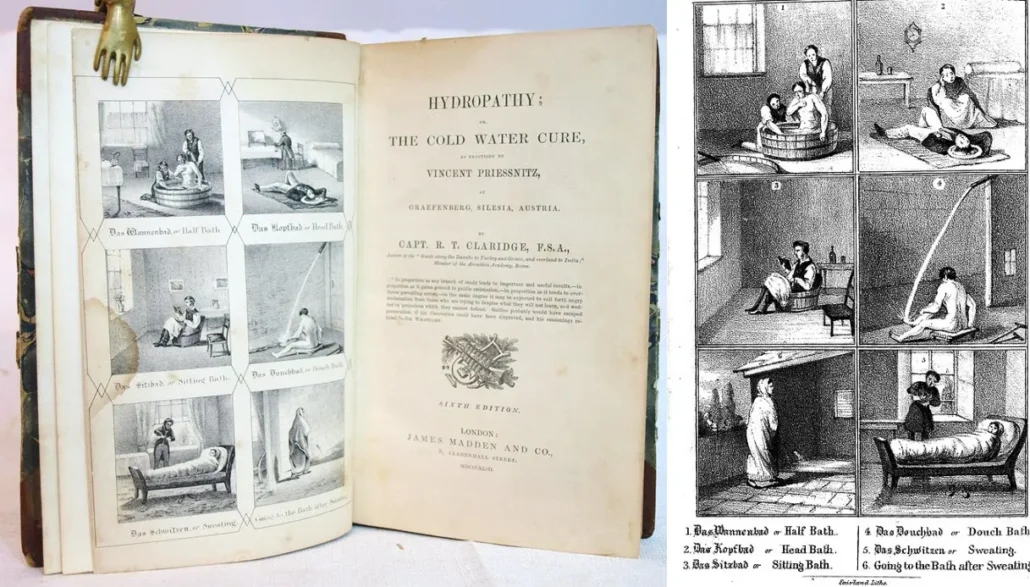
Left: Vincent Priessnitz’s Book on Hydrotherapy
Vincent Priessnitz, a pioneer of hydrotherapy, authored “The Cure of All Diseases by Water” in 1836. His groundbreaking book detailed various water-based treatments designed to harness the therapeutic properties of water for health and healing.
Right: Illustrations of Hydrotherapy Techniques
Top Left – Wood Bath: A man immersed in a wooden bath, assisted by two helpers. This scene demonstrates Priessnitz’s use of immersion baths to promote health and circulation.
Top Right – Head Bath: A man lying on the floor with his head in a bowl, a technique intended to treat headaches and other ailments by focusing on the head area.
Middle Left – Sitting Bath: A man seated in a wooden container, illustrating the use of sitting baths to address lower body issues and improve overall health.
Middle Right – Douche Bath: A person receiving a douche bath while sitting, showcasing the use of water jets for invigorating and stimulating the body.
Bottom Left – Sweating Bath: A lady enveloped in multiple layers of clothing, engaged in a sweating bath to induce perspiration and detoxification.
Bottom Right – Post-Sweating Bath: A lady entering a bath after a sweating treatment, demonstrating the practice of using water to cleanse and soothe the body following perspiration.
These illustrations from Priessnitz’s 1836 publication highlight the variety of hydrotherapeutic methods he advocated, reflecting the 19th-century enthusiasm for natural and non-invasive health treatments.
Franz Mesmer and Mesmerism
Franz Anton Mesmer, an Austrian physician, introduced mesmerism, or animal magnetism, in the late 18th century. Mesmer believed that an invisible magnetic fluid flowed through all living beings and that imbalances in this fluid caused illness. He developed techniques to manipulate this fluid and restore balance, using hand movements and iron rods to channel and redistribute magnetic energy.
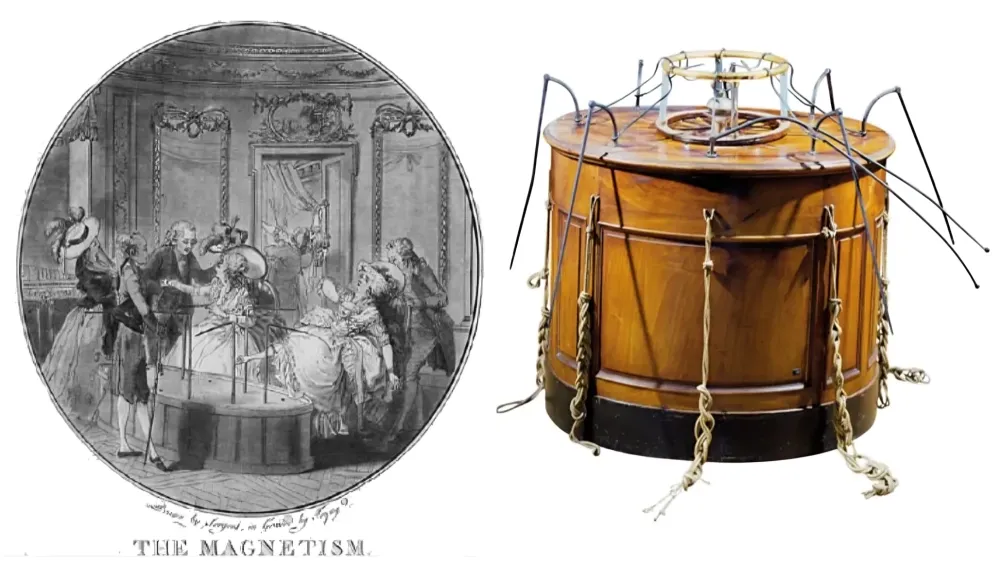
Left: Mesmerism Session Illustration (18th Century)
This illustration, titled “The Magnetism,” depicts an 18th-century scene where Franz Mesmer conducts a mesmerism session. Participants gather around a circular wooden tub, engaging in a practice believed to harness magnetic energy for healing. Mesmer’s theories of animal magnetism laid the groundwork for what would later become modern hypnotism.
Right: Mesmerism Tub (Baquet)
The detailed image on the right shows a baquet, a wooden tub equipped with metal rods and ropes, used in mesmerism sessions. Participants would touch the rods to receive the therapeutic effects of the supposed magnetic fluid. This device exemplifies the tools and techniques employed in Mesmer’s animal magnetism practices.
Mesmerism gained a substantial following and influenced the development of hypnotherapy and psychotherapy. Although Mesmer’s theories were later discredited scientifically, his work had a lasting impact on the understanding of the mind-body connection and the therapeutic potential of suggestion and belief. Mesmerism’s focus on the psychological aspects of healing contributed to the broader acceptance of holistic approaches in medicine.
The Emergence of Naturopathy, Herbalism, and Electropathy
Naturopathy emerged in the late 19th century, synthesizing various natural healing practices, including herbalism, hydrotherapy, nutrition, and lifestyle counseling. Founded by Benedict Lust, a German immigrant to the United States, naturopathy emphasized the body’s inherent ability to heal itself and the importance of treating the whole person—body, mind, and spirit.
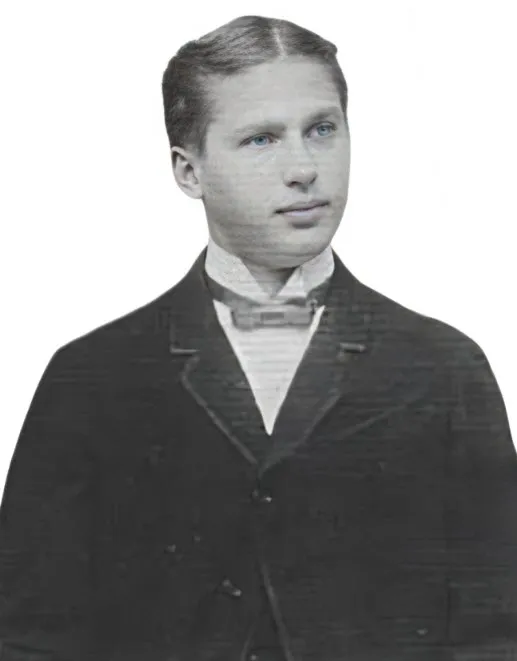
This portrait features Benedict Lust, a key figure in the development of naturopathy. As a young man, Lust dedicated himself to promoting natural healing practices, drawing from various traditions including hydrotherapy, herbalism, and nutrition. His work in the early 20th century helped establish naturopathy as a recognized and influential alternative medical system, advocating for the body’s inherent ability to heal through natural means.
Herbalism, the use of plants and plant extracts for medicinal purposes, experienced a resurgence during this period. Herbal remedies were seen as safer and more in harmony with the body’s natural processes compared to the harsh chemicals used in conventional medicine. Pioneers like Samuel Thomson in America promoted the use of indigenous plants for healing, challenging the dominance of pharmaceutical approaches.
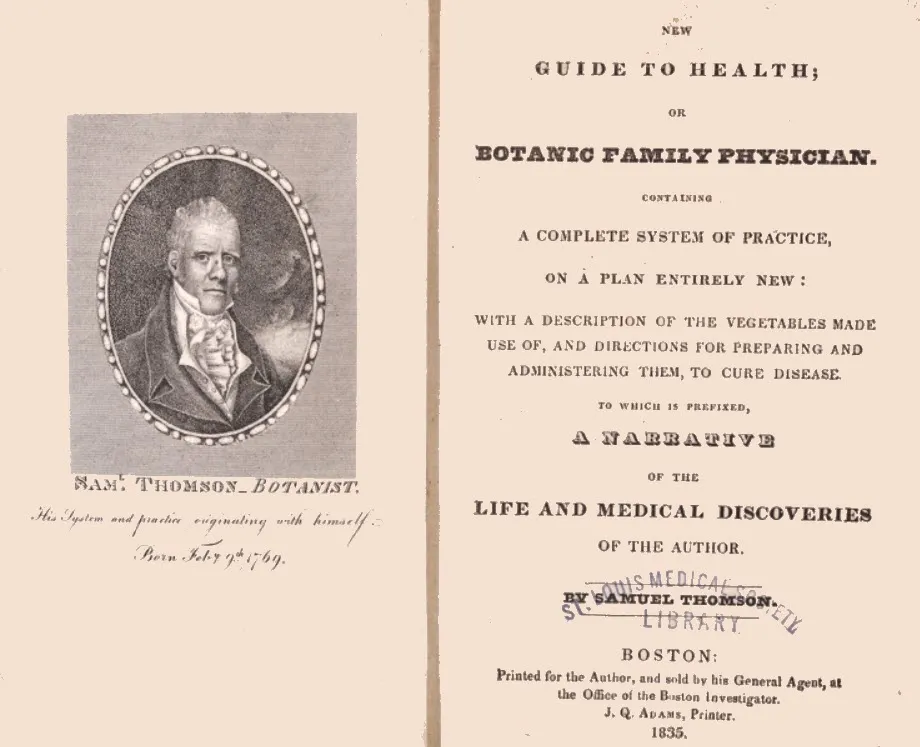
Left: Samuel Thomson (1769-1843), Botanist
This portrait depicts Samuel Thomson, a pioneer of American herbal medicine, whose system of botanic practice emphasized the use of native plants for healing.
Right: Title Page of Thomson’s Book (1835)
The title page of “New Guide to Health; or Botanic Family Physician” outlines Thomson’s innovative system of medical practice, which includes detailed descriptions of medicinal plants and their uses. Published in 1835, this work played a crucial role in popularizing botanical medicine in the United States.
Electropathy, or electrotherapy, also gained traction in the 19th century. Practitioners used electrical currents to treat various ailments, believing that electricity could stimulate healing and restore health. Devices such as electric belts and brushes became popular, reflecting the era’s fascination with electricity and its potential therapeutic applications.
The Influence of Phrenology and Hydropathic Cure
Phrenology, developed by Franz Joseph Gall, proposed that the shape and size of the skull could reveal personality traits and mental abilities. Although phrenology was eventually debunked, it enjoyed significant popularity in the 19th century and influenced the development of psychology and neuroscience.
Hydropathic cures, or the water-cure movement, were heavily influenced by the principles of hydrotherapy. Advocates like John Harvey Kellogg and Russell Thacher Trall promoted the use of water treatments alongside dietary changes, exercise, and other lifestyle modifications. Hydropathic institutions offered a variety of treatments, including baths, wraps, and enemas, all aimed at purifying the body and restoring health.
The Birth of Osteopathy
Andrew Taylor Still: A Brief Biography
Andrew Taylor Still, born on August 6, 1828, in Virginia, was a pioneering figure in the field of alternative medicine. He was the son of a Methodist minister and physician, which exposed him to both religious and medical influences from a young age. Still’s early education was limited, but his inquisitive nature and keen observation skills set the foundation for his future innovations in medicine. He worked as a physician during the Civil War, where he witnessed firsthand the limitations and brutalities of conventional medical practices, experiences that deeply influenced his later work.
Personal Tragedy and Its Impact on Still’s Medical Philosophy
A pivotal moment in Still’s life came in 1864 when he lost three of his children to spinal meningitis. This profound personal tragedy shook his faith in the conventional medical treatments of the time, which had failed to save his children. The loss drove Still to question the efficacy and morality of the medical practices he had been taught and to seek new ways of understanding and treating illness.
Still’s grief and disillusionment with orthodox medicine led him to an intense period of study and reflection. He delved into anatomy, physiology, and the principles of health, determined to find a more effective and humane approach to healing. This quest eventually led to the development of osteopathy, a holistic medical practice that emphasized the body’s inherent ability to heal itself and the importance of the musculoskeletal system in maintaining overall health.
Beyond Personal Loss: Intellectual and Cultural Influences
While the personal tragedy was a significant catalyst, Still’s medical philosophy was also shaped by broader intellectual and cultural influences of his time. The Enlightenment, with its emphasis on reason, empiricism, and skepticism of traditional authorities, played a crucial role in shaping Still’s thinking. He was influenced by the scientific advancements and the growing body of knowledge about human anatomy and physiology. Still believed that a better understanding of the body’s structure and function could lead to more effective treatments and improved health outcomes.
Influence of Enlightenment Ideals
Enlightenment ideals, particularly the emphasis on rational inquiry and empirical evidence, were central to Still’s approach. He rejected the mystical and superstitious elements often associated with traditional medicine and instead sought to ground his practice in observable and verifiable principles. This scientific rigor was combined with a holistic view of health, reflecting the Enlightenment’s broader impact on 19th-century thought.
Still’s osteopathic philosophy also aligned with the Enlightenment’s focus on individual autonomy and self-reliance. He believed in empowering patients by educating them about their own bodies and encouraging them to take an active role in maintaining their health. This approach contrasted sharply with the paternalistic model of conventional medicine, where patients were often passive recipients of treatment.
Criticism of Heroic Medicine
A significant aspect of Still’s critique of conventional medicine was his opposition to “heroic medicine,” which dominated medical practice in the 19th century. Heroic medicine involved aggressive treatments such as bloodletting, purging, and the use of toxic substances like mercury. These interventions were based on the belief that drastic measures were necessary to balance the body’s humors and expel disease.
Still viewed these treatments as not only ineffective but often harmful. He argued that such practices weakened the body’s natural defenses and ignored the underlying causes of illness. In contrast, osteopathy emphasized gentle, non-invasive techniques aimed at restoring the body’s natural balance and promoting its self-healing capabilities.
Emphasis on Holistic Health and the Body’s Self-Healing
Central to Still’s osteopathic philosophy was the concept of the body as an integrated whole, with an inherent ability to heal itself. He believed that health was maintained through the proper alignment and function of the musculoskeletal system, which he saw as crucial to the body’s overall well-being. By ensuring that the bones, muscles, and joints were correctly aligned, osteopathy aimed to improve circulation, reduce nerve interference, and enhance the body’s natural healing processes.
This holistic approach was in stark contrast to the reductionist methods of conventional medicine, which often focused on treating specific symptoms or diseases in isolation. Still’s emphasis on the interconnectedness of the body’s systems reflected a broader cultural shift towards holistic health practices, which were gaining popularity in the 19th century.
Osteopathy in Context
Comparison with Other Alternative Medical Practices
Osteopathy, developed by Andrew Taylor Still in the late 19th century, shared similarities with other contemporary alternative medical practices in its holistic approach and emphasis on the body’s self-healing capabilities. However, it also had distinct differences that set it apart.
Homeopathy, founded by Samuel Hahnemann, relied on the principle of “like cures like” and involved the use of highly diluted substances to stimulate the body’s healing response. While both osteopathy and homeopathy emphasized gentle, non-invasive treatments, osteopathy focused more on the structural integrity of the body and manual manipulation techniques to restore health.
Hydrotherapy, popularized by Vincent Priessnitz, used water treatments to promote healing. This practice was based on the idea that water could purify and rejuvenate the body, similar to how osteopathy aimed to restore the body’s natural balance. However, osteopathy’s emphasis on the musculoskeletal system and manual adjustments distinguished it from the primarily external treatments of hydrotherapy.
Franz Mesmer’s mesmerism, or animal magnetism, involved manipulating a supposed magnetic fluid in the body to treat illnesses. Mesmerism’s focus on unseen forces and the mind-body connection had some conceptual overlap with osteopathy’s holistic perspective, but osteopathy’s grounding in anatomical and physiological principles gave it a more tangible and scientifically accessible foundation.
Naturopathy, which combined various natural therapies including herbalism, hydrotherapy, and lifestyle counseling, shared osteopathy’s holistic approach and emphasis on prevention and self-healing. However, osteopathy’s specific focus on the musculoskeletal system and the use of manual therapy techniques provided a unique approach to health and healing within the broader context of alternative medicine.
Early Reception and Development of Osteopathy
Osteopathy’s early reception was mixed. On one hand, it garnered significant interest and support from those dissatisfied with conventional medical treatments, which were often invasive and harsh. Patients appreciated osteopathy’s gentle, holistic approach and its emphasis on the body’s natural ability to heal itself.
However, the established medical community was initially skeptical and often hostile towards osteopathy. Many conventional physicians viewed it as unscientific and questioned its efficacy. This skepticism was fueled by the broader resistance to alternative medical practices that challenged the dominance of allopathic medicine.
Despite this opposition, osteopathy began to gain traction. In 1892, Andrew Taylor Still founded the American School of Osteopathy in Kirksville, Missouri, to formally teach and promote his methods. The school’s curriculum included anatomy, physiology, and manual manipulation techniques, providing a structured and comprehensive education for osteopathic practitioners. This institutionalization helped legitimize osteopathy and establish it as a credible medical practice.
Osteopathy’s appeal continued to grow, particularly among patients seeking more compassionate and holistic care. Its focus on preventive health and the importance of lifestyle factors resonated with the cultural shifts towards self-reliance and natural health practices. As more practitioners trained in osteopathy and demonstrated its effectiveness, the practice gradually gained broader acceptance.
The Legacy of Andrew Taylor Still and Osteopathy’s Evolution
Andrew Taylor Still’s legacy extends far beyond his initial development of osteopathy. His holistic approach to health and emphasis on the body’s self-healing capabilities have had a lasting impact on the field of medicine. Osteopathy’s evolution has seen it adapt and integrate into mainstream healthcare, particularly in the United States.
In the early 20th century, osteopathy began to gain formal recognition. In 1917, the American Osteopathic Association (AOA) was founded to advance the interests of osteopathic physicians and promote high standards of practice. This was a significant step towards professionalization and standardization within the field.
Over time, the scope of osteopathic practice expanded to include a broader range of medical treatments and interventions. Today, osteopathic physicians (DOs) in the United States are fully licensed to practice all aspects of medicine, including surgery and prescription of medications, similar to their allopathic counterparts (MDs). Osteopathic medical schools now provide comprehensive education in both conventional medicine and osteopathic principles, ensuring that practitioners are well-equipped to address a wide variety of health issues.
Despite its integration into mainstream medicine, osteopathy has retained its distinctive emphasis on holistic care and the musculoskeletal system. Techniques such as osteopathic manipulative treatment (OMT) continue to be a key component of osteopathic practice, reflecting Andrew Taylor Still’s original vision.
Internationally, osteopathy has also gained recognition and acceptance, though the scope of practice and regulatory frameworks vary by country. In many places, osteopaths are recognized as complementary health practitioners who provide manual therapy and holistic care.
Andrew Taylor Still’s pioneering work laid the foundation for a medical practice that continues to evolve and adapt to modern healthcare needs. Osteopathy’s enduring legacy lies in its commitment to treating the whole person, its respect for the body’s innate healing abilities, and its focus on preventive care and patient empowerment. As healthcare continues to advance, the principles of osteopathy remain relevant, offering a valuable perspective on the interconnectedness of the body, mind, and spirit.
Conclusion
Reflecting on the Historical Context of Alternative Medicine
The 19th century was a pivotal period in the history of medicine, marked by significant social, intellectual, and scientific transformations. This era saw the emergence of various alternative medical practices that challenged the conventional medical paradigms of the time. The surge in alternative medicine was driven by a combination of factors, including disillusionment with the often harsh and ineffective treatments of conventional medicine, a growing emphasis on individualism and self-reliance, and the broader cultural and intellectual currents of the Enlightenment and Romanticism.
The Enlightenment, with its focus on reason, empirical evidence, and skepticism of traditional authority, laid the groundwork for a more scientific and investigative approach to medicine. This intellectual movement encouraged practitioners like Andrew Taylor Still, Samuel Hahnemann, and Franz Mesmer to question existing medical practices and seek new, more humane and effective methods of treatment. The Romantic era further influenced this shift by emphasizing the importance of nature, holistic health, and the interconnectedness of the mind, body, and spirit.
Personal experiences and tragedies also played a crucial role in shaping the philosophies of many alternative medicine pioneers. For instance, Still’s profound personal loss and his dissatisfaction with conventional treatments led him to develop osteopathy, a practice that emphasized the body’s self-healing abilities and the importance of the musculoskeletal system. Similarly, Hahnemann’s disillusionment with the medical practices of his time prompted him to create homeopathy, a gentler and more individualized approach to healing.
The Enduring Impact of 19th Century Innovations on Modern Medicine
The innovations in alternative medicine that emerged in the 19th century have had a lasting impact on modern medicine, shaping contemporary healthcare practices and philosophies in significant ways. Many principles and practices developed during this period continue to influence and inform medical approaches today.
One of the most enduring legacies of 19th-century alternative medicine is the holistic approach to health and healing. This perspective, which views the body as an integrated whole and emphasizes the interconnection between physical, mental, and emotional well-being, has become increasingly accepted in modern healthcare. The holistic approach encourages a more comprehensive understanding of health, considering not just the symptoms of disease but also the underlying causes and the overall well-being of the patient.
Osteopathy, founded by Andrew Taylor Still, is a prime example of how 19th-century innovations have persisted and evolved. Today, osteopathic physicians (DOs) are fully licensed medical practitioners who integrate osteopathic principles with conventional medical practices. The emphasis on manual therapy, the musculoskeletal system, and the body’s self-healing capabilities remains central to osteopathy, reflecting Still’s original vision. This integration of osteopathic principles into mainstream medicine highlights the enduring relevance and effectiveness of these early innovations.
Homeopathy, despite its controversial status and the ongoing debate over its efficacy, continues to be practiced worldwide. Its emphasis on individualized treatment and the body’s innate healing response has influenced other areas of complementary and alternative medicine. The popularity of homeopathic remedies, particularly in regions like Europe and India, underscores the lasting appeal of Hahnemann’s approach.
The broader acceptance of natural and non-invasive treatments in modern medicine can also be traced back to the 19th-century alternative medical practices. Hydrotherapy, herbalism, and other naturopathic treatments have seen a resurgence in recent years, as more people seek holistic and preventative healthcare options. The focus on lifestyle factors, such as diet, exercise, and stress management, reflects the principles championed by early naturopaths and continues to shape contemporary health practices.
Moreover, the patient-centered approach that characterized many 19th-century alternative medical practices has become a cornerstone of modern healthcare. The emphasis on patient education, empowerment, and active participation in their own health aligns with current trends towards personalized medicine and shared decision-making. This shift towards a more collaborative and individualized approach to healthcare can be seen as a direct legacy of the pioneering work of alternative medicine practitioners like Still and Hahnemann.



